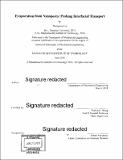Evaporation from nanopores : probing interfacial transport
Author(s)
Lu, Zhengmao
DownloadFull printable version (9.860Mb)
Other Contributors
Massachusetts Institute of Technology. Department of Mechanical Engineering.
Advisor
Evelyn N. Wang.
Terms of use
Metadata
Show full item recordAbstract
Evaporation, a commonly found phenomenon in nature, is widely used in thermal management, water purification, and steam generation as it takes advantage of the enthalpy of vaporization. Despite being extensively studied for decades, the fundamental understanding of evaporation, which is necessary for making full use of evaporation, remains limited up to date. It is in general difficult to experimentally characterize the interfacial heat and mass transfer during evaporation. In this thesis, we designed and microfabricated an ultrathin nanoporous membrane as an experimental platform to overcome some critical challenges including: (1) realizing accurate and yet non-invasive interface temperature measurement; (2) decoupling the interfacial transport resistance from the thermofluidic resistance in the liquid phase and the diffusion resistance in the vapor phase; and (3) mitigating the blockage risk of the liquid-vapor interface due to nonevaporative contaminants. Our nano device consisted of an ultrathin free-standing membrane (~200 nm thick) containing an array of nanopores (pore diameter ~100 nm). A gold layer deposited on the membrane served as an electric heater to induce evaporation as well as a resistive temperature detector to closely monitor the interface temperature. This configuration minimizes the thermofluidic resistance in the liquid and mitigates the contamination risk. We characterized evaporation from this nano device in air as well as pure vapor. We demonstrated interfacial heat fluxes of ~~500 W/cm² for evaporation in air, where we elucidated that the Maxwell- Stefan equation governed the overall transport instead of Fick's law, especially in the high flux regime. In vapor, we achieved kinetically limited evaporation with an interfacial heat transfer coefficient up to 54 kW/cm² K. We utilized the kinetic theory with the Boltzmann transport equation to model the evaporative transport. With both experiments and modeling, we demonstrated that the kinetic limit of evaporation is determined by the pressure ratio between the vapor in the far field and that generated by the interface. The improved fundamental understanding of evaporation that we gained indicates the significant promise of utilizing an ultrathin nanoporous design to achieve high heat fluxes for evaporation in thermal management, desalination, steam generation, and beyond.
Description
Thesis: Ph. D., Massachusetts Institute of Technology, Department of Mechanical Engineering, 2018. Cataloged from PDF version of thesis. Includes bibliographical references (pages 82-87).
Date issued
2018Department
Massachusetts Institute of Technology. Department of Mechanical EngineeringPublisher
Massachusetts Institute of Technology
Keywords
Mechanical Engineering.